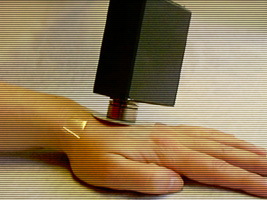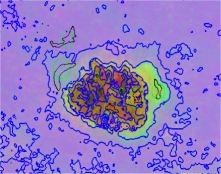Demonstrator project: Apparatus for skin imaging
and skin image representation
Construction of a vision-based system for acquisition
of dermatological images. The system integrates light
box, lighting, sensor, computer, and software. Standardized
lighting conditions, color and geometric calibration
provides the standardized images that are required
for comparative studies in distributed databases.
A carefully designed human-computer interface will
make the system operational for non-specialists. A
larger scale system for industrial surfaces has already
been developed in the "Vision-based measurements"
project at IMM sponsored by the Danish Center for
IT-technology. The system should be constructed and
optimized for dermatological images, and this includes
considerations on appropriate lighting, wavelengths,
sensors, and algorithms. Besides storing standardized
images the system should store summarizations of the
images based on visual cues like color, texture, and
size and shape of specific features. The group has
an extensive experience on this from the EU ESPRIT
project CATIE (Color and Texture Inspection Equipment)
that has been running since early 1996.

Diagnosis support systems
Malignant Melanoma is the most lethal of skin cancers.
The neural network group has worked with the Department
of Plastic Surgery, Rigshospitalet, for several years
on a pattern recognition system for diagnosis support
based on skin microscopy. Based on the advanced skin
imaging systems mentioned above and implementation
of more robust color measures and a richer set of
features we will develop a demonstration system for
visual detection of Malignant Melanoma. A promising
collaboration with the Department of Dermatology at
Bispebjerg Hospital, based on skin sample (and possibly
later in vivo) Raman Spectroscopy will add new possibilities
for diagnosis support in this important application
area.
Datamining in distributed medical databases
In line with the definition of telemedicine given
above these systems serve dual purposes: they can
assist medical research and in the clinic medical
diagnosis for medical professionals and secondly,
they can be used as information sources for patients.
Fact finding in distributed medical databases by use
of advanced machine learning methods can be used to
extract important information for the medical scientist.
Furthermore, such visual datamining can be used to
search for image analogies for patients directly on
the internet, say by search for similar images of
rashes, allergies or other skin lesions. Visualization
of high-dimensional datasets is very important for
understanding complex distributed databases. Visualization
and hypertext tools are concurrently being developed
for the field of neuroimaging within a THOR project
granted in the field of neuroinformatics. Similar
ideas are pursued by the international organization
"Internet Dermatology Society''
- Link
to Internet Dermatology Society
Novelty detection in video and image signals
Common to several medical imaging problems is the
need for tracking change over time in image sequences,
video footage or other measurements. Modern statistical
techniques such as Bayesian density modeling can be
used to model normal behavior, hence used to detect
abnormal behavior and significant change. Dermatological
applications are multiple within monitoring of skin
lesion and wound healing. The Image Analysis Group
has extensive experience in estimation of optical
flow. If a large number of consecutive and well registered
images can be taken of the area of interest estimation
of image flow will result in the estimation of whether
a lesion "grows'' or "shrinks'' and the
speed growth or shrinkage. Another possible scheme
is inspired by a multivariate statistical technique
called canonical correlations. Here the collection
of images over time is analyzed in order to find changes
in a multivariate fashion. Earlier work has analyzed
both a bitemporal model the truly multitemporal problem.

|